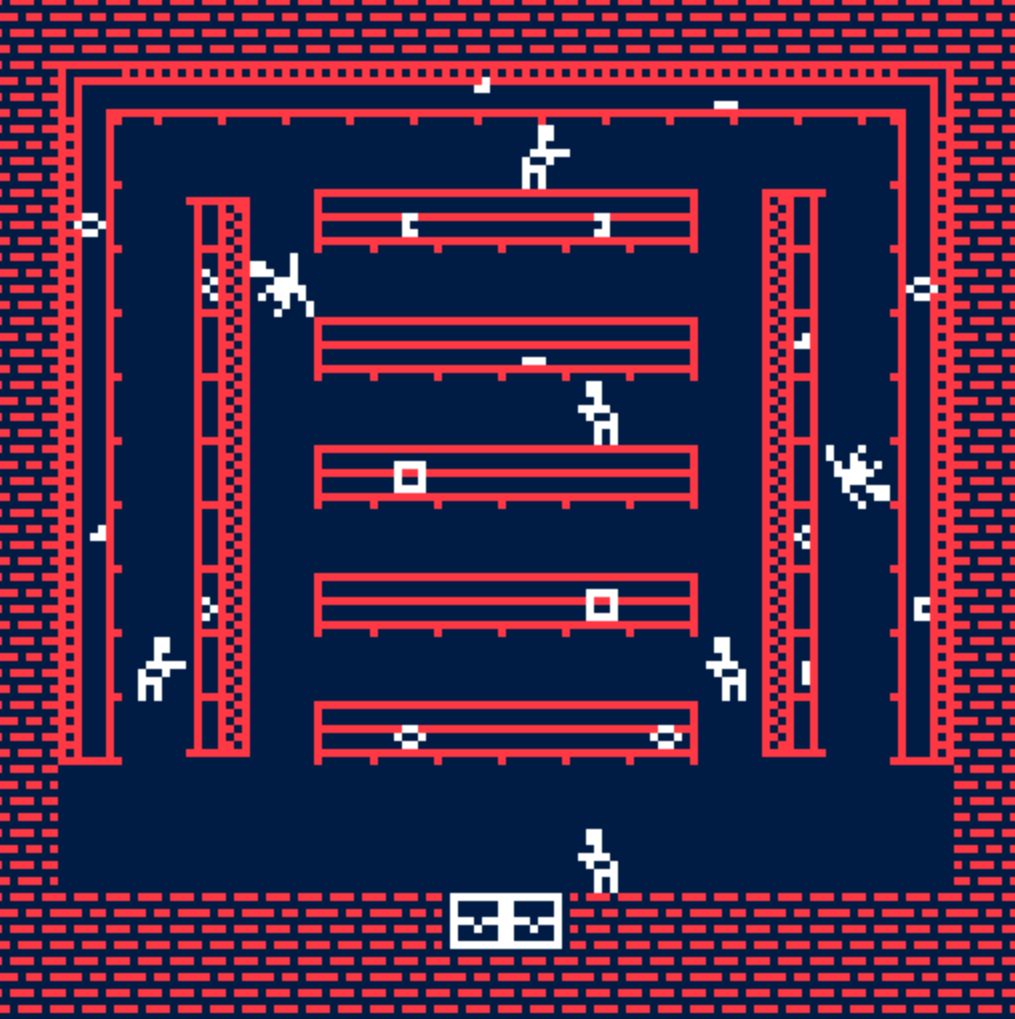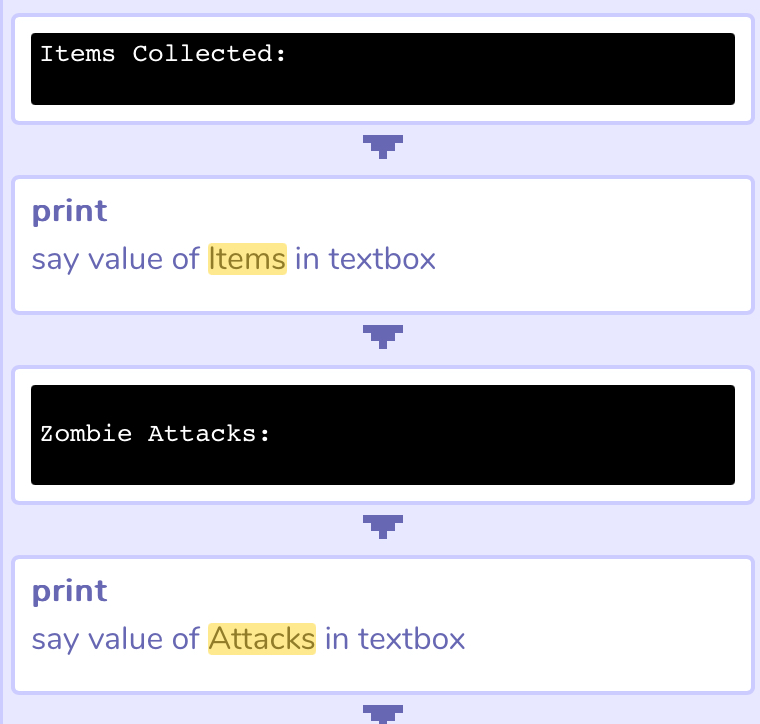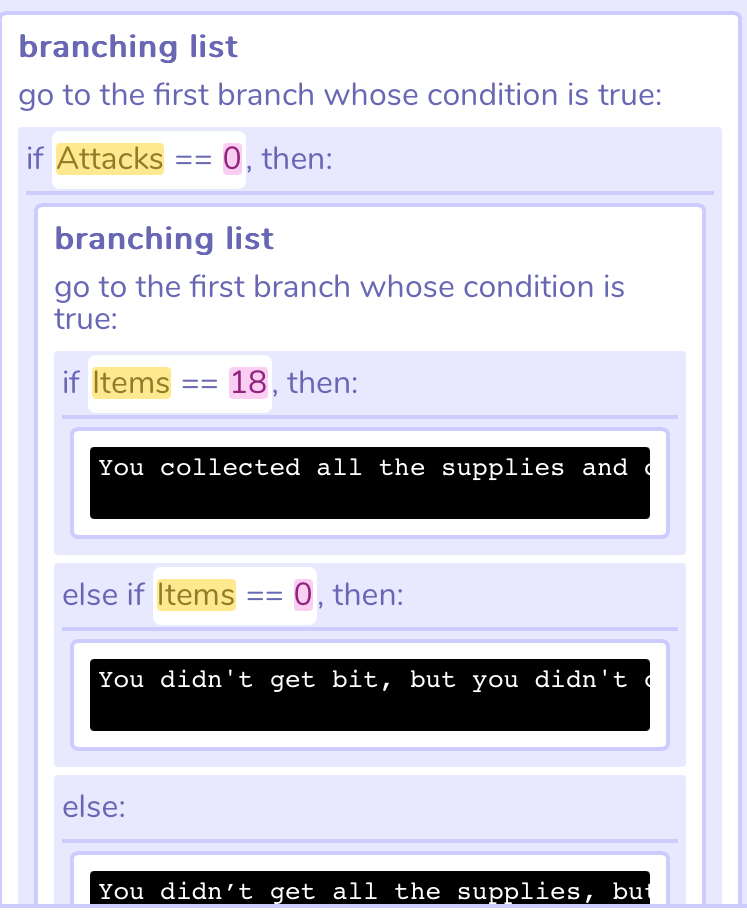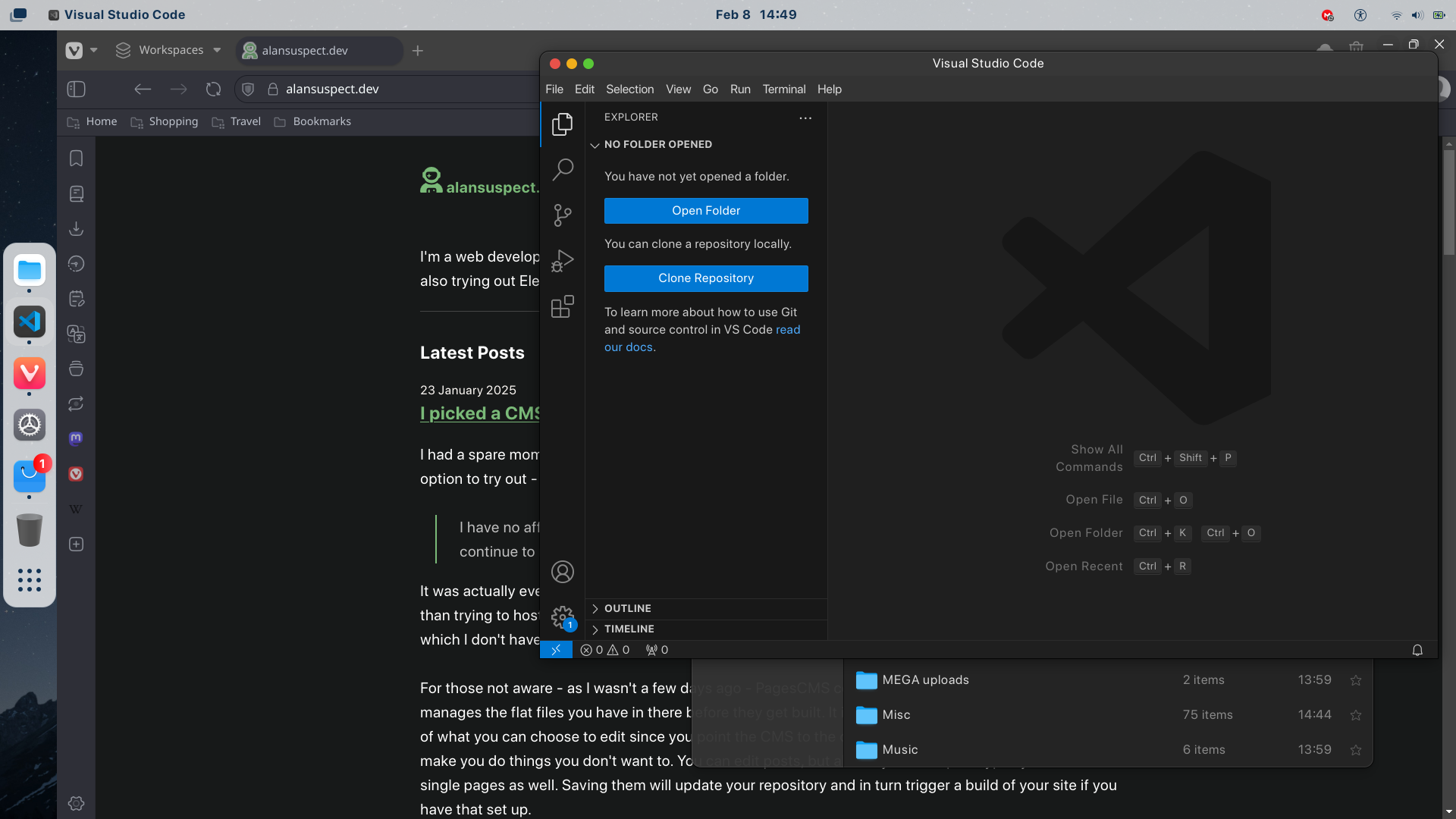Blog
-
Among many things, I build a lot of WordPress sites for my clients. For the most part I use Elementor, ACF, and other stuff, and tend to leave the actual block post editor alone. My clients are often responsible for general post/page content.
Last week I had to do a bunch of editor work and wow - I didn't realise how unusable the block editor is:
-
for the most part there is no indication where you're dragging a block to
-
the toolbar popup constantly gets in the way
-
just a general lack of good UX practice
-
so much white space for no reason
-
the up/down arrows are useful, but thet don't work cross-block, so if I have a paragraph and want to put it inside a column I can't. Press up and it goes above the column block.
There are more, these are just off the top of my head. I'm a little surprised but also not very surprised, WordPress has been changing for the worse for a long time, but it still broadly a decent CMS.
That's not to say the old TinyMCE editor was any better, but mixing content and layout is always a messy situation and I don't think either editors handle it well.
I much prefer how modern editor's approach this and use Markdown, and no interpretation of layout (columns, etc), however WordPress have heavily invested in their block editor so I can't see them changing any time soon.
-
-
Well I did it, I've officially had an active blog for a year now.
I think it's the longest I've ever kept a blog going - and at 14 posts I'm not exactly winning any records - but sticking to things isn't my forté so I'm pretty chuffed with myself.
Looking back, I've enjoyed playing with Eleventy (more to come on that in future posts); discovering itch.io and all the amazing games on there; and also finding bitsy and making several fun games.
So here's to the next year, and seeing what else I can add to this site.
-

The last couple of bitsy games I've made have focused more on the design and aesthetics of the game rather than the functionality and gameplay.
That was mostly due to the types of games/stories I had opted to tell; this time I had an idea that was more limited in scope but involved different mechanics.
Given the theme of 'supermarket' I instantly had the idea of running around a supermarket in a post-apocalyptic zombie situation, as I'm sure we all would.
Side note: you can play the game direct in your browser right here: https://alansuspect.itch.io/supply-run
In my original idea I thought about the supplies randomly appearing each time the game was played, but it's either not possible in bitsy, or far beyond my abilities. I might come back to this idea in the future, maybe even on another platform.
So for this I just created several different 'supplies' (in the game dev these are listed variously as 'fruit', 'veg', 'chips', etc but not listed in the game itself), and placed them randomly around.
Due to the design of the shelves in the supermarket I had to make the tiles that the supplies sit on non-wall tiles so the character can pick them up (which also throws out the random supply placement idea).
One thing I knew I could do in bitsy was display random text each time an action happens. So each time the character walks into a zombie the sounds the zombie makes a different. After the random action I then added a quick palette-switch-and-back to a reverse palette, to give that injured red flash.
Lastly, I wanted to add some kind of message at the end rather than just have the game end. It's fairly easy to add a variable to the text so the next step was to count each time a supply is collected and each time a zombie attacks.

Once the counting variable is ready I add it to the text message at the end. Easy!
Still, it's not super exciting. I then decided to try out the if/then/else to display a message based on the results.
I tried writing out the logic but it doesn't look right. Basically it checks if Attacks = 0 first, and if so then if all supplies were collected you get the congrats message. If no attacks but not all supplies were collected you get a different message. Lastly (and I was running out of time) if Attacks >= 1 you get the 'bit' message, bad luck!

And I think that's about it. I enjoyed playing with bitsy's mechanics more this time - for a simple game maker it actually allows for a lot of experimentation. Give it a go yourself!
-
I have an old MacBook Air 13" from 2019 which was my work horse for a while until I forked out for a new iMac last year. It comes in handy sometimes when I need to do work away from my desk but it's pretty slow so that's mostly limited to simple coding stuff.
Recently I've been adding self-hosting platforms to it - namely Jellyfin and other media-related treats.
A while back I came across Kavita, an ebook organisation platform in a similar vein to Jellyfin but for ebooks. I keep all my ebooks in a folder and occasionally sort through them using Calibre, which is great for tweaking metadata and all that.
I sync my local files with MEGA.io so everything is backed up, and I also share the local MEGA folder (the main sync is on my iMac) with the MacBook Air so it can access all the files. This is handy for both coding and ebook management.
So I've set Kavita up now and it has imported all my books. Some of the metadata is off so I'll need to do some tidying up in Calibre, but so far so good. I also set up the email-to-device config so if I add new ebooks to Kavita first I can then send them to my Kindle. Easy!
-
We've had a Dell Inspiron laptop knocking around for a couple of years now and I've never known what to do with it.
One time I tried installing Batocera and then ChimeraOS on it to use as a console in the living room but got bored with the fiddling and it wasn't a good set up anyway.
I've recently come across ZorinOS and liked the look of it. It has been suggested for people moving from Windows, but ironically I found it more macos-like - especially after a few UI tweaks.
My daily driver is an M3 iMac and I use an old MacBook Air for some home server stuff, and when I need it I can use the Air for some dev work. It's a slow machine though and I don't like using it for that.
I'm hoping if I need to do work away from my desk now I can use this laptop instead.
Here's my desktop with Mac-style tweaks:

-
I had a spare moment yesterday [sorry, a what?] so I jumped in with the most straight-forward looking option to try out - PagesCMS.
I have no affiliation with this platform so anything positive below is sincere and I will continue to review it as I use it as my CMS.
It was actually even easier than I expected to set up, although I did go with the hosted version rather than trying to host it myself since their instructions only cover Vercel and involve setting up a database, which I don't have time to manage at this point.
For those not aware - as I wasn't a few days ago - PagesCMS connects to your GitHub account and manages the flat files you have in there before they get built. It is also completely customisable in terms of what you can choose to edit since you point the CMS to the content, it doesn't take over or try to make you do things you don't want to. You can edit posts, but also any custom post types you have and single pages as well. Saving them will update your repository and in turn trigger a build of your site if you have that set up.
Once the initial account signup process is done (via GitHub) I am presented with a dashboard where I can see my current repository, add new ones, create a new project or even add another GitHub account.
The most important thing you need to do is add a config file. The docs are well written and even have an 11ty example config file to get you started.
My blog is based off the eleventy-base-blog-v8 so is a little out of date and honestly at some point I plan on changing it to something homemade - but that's getting off on a tangent. The downside here is that I wrote additional pieces of text content (such as the blurb on my homepage) like this:
module.exports = { description: "I'm a web developer based in Australia. I build with Wordpress, Shopify and now also Eleventy, sometimes mixing them all together.", }But in the config file it only likes JSON for this format, so 'description' doesn't auto-populate and is uneditable. I'm not sure if this was something I did for some reason, or if v8 of the blog did this and was changed for v9.
This also goes for my About page and site meta as well; it's not an issue as I'm not planning on changing these immediately, but worth noting for future reference.
Another issue I ran into was getting my post tags working. I like the way these work in Eleventy, generating a post list for each tag and wanted to be able to edit these easily in the CMS too. After searching the GitHub issues page I came across the answer, which it turned out was also in their docs all along. Here's the important part of my config file covering the posts:
content: - name: blog label: Blog type: collection path: 'content/blog' filename: "{fields.title}.md" view: fields: [ title, description, date, tags ] fields: - name: title label: Title type: string - name: description label: Description type: string - name: date label: Date type: date - name: tags label: Tags type: string list: true fields: - name: tag label: Tag type: string - name: body label: Body type: rich-textIn this config I added:
-
'filename' - I added this in because I like to use the title as the post slug. In Obsidian I was doing this manually in the frontmatter so it's nice to automate it. You can also use variables like {year} to build a slug.
-
fields > name: tags - this got my tags in place by using the 'list' field type. It will then repeat the fields within for each entry, so here I just have a single text field for each tag.
However, although this creates a nice interface for adding new tags and correctly adds the tags frontmatter to my post, the build fails each time and I cannot figure out why.
This is how the tags selection should look in the CMS, but unfortunately when I add any tags it breaks the build:

If I can get this working it will mean I can keep adding tags, the only downside is I can't see tags I've already added to reuse but I tend to write them off the cuff anyway. Also in the config you can have min/max settings to limit these options as well.
This is my first post written using PagesCMS (and that above is my first embedded image in the entire blog so fingers crossed) so we'll see how it goes, but I would like to get my tags working.
I mentioned earlier about changing my blog theme and having a functional CMS has made me think about how I want to redo that as well, but I also need to figure out what I want from this blog too.
If you are currently manually editing your markdown files for your Eleventy blog and want an easier way to handle things, give it a shot. I'll try and keep updates on using it and any issues I may run into.
-
-
Is there a flat-file CMS I could point to my Eleventy dev folder that would act as a nice front end to manage the Markdown content?
I've looked at a few (such as Grav, TinaCMS, Pico CMS, SpinalCMS) but they seem to do their own thing and manage files/site themselves, whereas I'd want Eleventy to handle everything and just have a nice UI instead of dealing with files.
The idea being when you save a post/page (.md file) it would update the e.g. GitHub repo and trigger the build. Any ideas?
Bonus points for being open source and also an accommodating free plan, or at least decent upgrade levels that don't go from free to $500 pm for an additional seat.
Mattrbld looks good but I'm not sure how mature/stable it is and so does PagesCMS if it can do what I'm after. I guess it also depends on hosting and my options there too.
-
I was watching the news this morning and they were talking about Green Day and the new 'dynamic pricing' for gig tickets being used, which basically means if more people are trying to book tickets the price will go up.
It's not just Green Day either, it's the ticket companies pushing the feature.
It's a horrific capitalism invention and all I can say is people should go check out local bands instead. This is just making nice things available only to the rich.
My question is, why can't we make these ticket companies pay a tax that goes towards local music/art investment?
This was done with Netflix; they have to commit to making a certain amount of Aussie content per year. If you're taking money from people to go see major foreign acts, some of that should be reinvested.
I hate capitalism, it ruins nice things.
-
I keep coming back to reading about web components.
The opportunity to try them out hasn't come up yet but I still don't think I get it. Is it just another way of sneaking JavaScript into a site build? Do they work without JavaScript?
With all the Eleventy talk about moving to Font Awesome and their Web Awesome stuff I really want to learn it and like it, but I'm coming at it from an HTML/CSS-only standpoint (static sites lend themselves to a lack of JS) and am trying to understand how it carefully adds to a build, instead of taking it over or relying on JS. Or maybe I'm way off.
For several years now I've used "builders" for some clients, mostly on WordPress, which are a swamp of JavaScript and awful performance. So as I look to simpler project builds in the future I want to factor in nice solutions for things that aren't going to turn into a hassle down the line.
The idea of browsers supporting it sounds fantastic though. Maybe I'll figure it out one day.
-
I have had this idea for a computer game for a while now, it's not completely fleshed out but I have a rough storyline down and a few ideas for puzzles.
What I can't decide on is how to implement it. Issues of time aside, I'm also not a skilled game developer so an easy learning curve would be preferable.
I like doing pixel art so that would be a nice path to go down, but I probably shouldn't commit to doing too much of it as I'll end up giving up before I get anywhere.
My first thought is a point-and-click adventure game like LucasArts used to make. When I was a kid I played with GRAC on the Amiga and I can see similar programs exist now, such as Escoria and Popochiu add-ons to Godot.
I even got sidetracked looking at Godot add-ons and found Cogito. For a brief moment considered a first person puzzler, but have no idea about 3D graphics.
Going to the far end on the other side I thought about doing an interactive fiction piece, where the story and puzzles would be a lot easier to implement and I could incorporate some static pixel art along the way.
Lastly I've been trying out some games on the iPad which are kind of a mix of interactive fiction and point and click, in fact they call themselves point and click games but I consider them more first person point and click, for clarity.
I even found an add-on for Godot called EgoVenture which does this kind of thing. It would mean I can do static graphics (without all the pesky animating characters walking stuff) and keep things as simple or complex as I like. On top of that, I could implement some cool puzzles.
Oh, and a bonus mention to GBStudio which looks awesome, but not sure it would suit my game style. Maybe for another project.
Lots of coulds in there! How do other people figure out how to plan a project like this? Do you do a script/plan layout or just get started and figure it out as you go?
-
I'm not great at JavaScript. Never have, never will, and I'm ok with that. I understand enough and can follow many others' leads to do what I want with it.
Or, even better, just not use it. I grew up with HTML, then added CSS along the way. That was always enough.
At one point I had this stomach-dropping feeling that I may need to learn React to keep doing my job. That meant learning React AND JavaScript. No thanks.
Now I see several articles, posts, and mentions a week about how over-reliance on JS is damaging user experience, how it is creating a pointless situation when things could be much simpler.
And I'm glad. It wasn't the way things were going after all, just the way some people thought it should and we all got swept up along the way.
Some of the tools I use in my day-to-day website building activities are very JS-heavy, and it is starting to show. Simple web builders are now bloated to the point they can't perform their basic functions without difficulties (and let's not get started on the shoe-horned AI obsession).
Now I just need to convince my clients they don't need all the bells and whistles!
-
Something happened today.
I actually picked up a guitar and made up some new music. It wasn't much, just a few riffs but it's been so long. I'm just constantly working and don't put time aside for my activities.
And it was on bass. I bought a Fender p-bass a long, long time ago and hardly ever play it. I'm a guitarist by trade but it always seemed like a neat thing to have, especially if I want to record anything.
I also recorded it on my phone as I will very likely forget it, which is pretty cool. I remember when I was young I had a MiniDisc recorder to record demo tracks, and later audio software like Cubase. I used Cubase to record Suspect Package's first (and only) album.
But it was nice to just feel free to play something today. Maybe I'll keep doing it. I should keep doing it.
-
We've had an old (2021) Dell laptop lying around for a while and I thought turning it into a gaming machine for the living room might be fun.
Now when I say gaming, I'm not really a gamer. I grew up playing point and click adventures (still the best game format in my opinion) and in the late 00's I had an XBox 360 where I played a lot of Red Dead Redemption. Oh, and I have a WiiU in a box somewhere but it has a UK plug and it seems dangerous to have it plugged in to an adapter all the time.
I like playing old games. I got my daughter a Miyoo game boy-style handheld for Christmas and under the guise of "testing" to make sure it would be good to go on the big day I also picked one up for myself.
I've looked into a few options for this Dell laptop (Inspiron 5502 for those who are wondering, whatever that signifies), I'm not a big PC guy - I use a Mac as my daily driver - so removing Windows was a priority. I've played with Linux here and there over the years so that's always an option.
I first tried Batocera, a convenient living room display-style screen mode for retro gaming but I wasn't able to install it off the USB stick to the drive in the laptop.
So now I'm trying out ChimeraOS. It bases itself off Steam so I can access games I have on there, as well as retro emulated games.
I've realised I don't actually have any games in Steam so the homepage is a little lackluster right now (mainly Half Life when it was on a free promo and classic YNAB), but that can be added to.
I found my old WiiU Pro controller and it connected instantly which I was impressed with. The next step is to get Steam Link working on my iPad so I can play some new point and click games I've been interested in but they're only on PC.
Now I need to find some time to actually play some games...
-
I just read this post by @mxbck@front-end.social.
This is an older one but there are a lot of posts like this popping up and it's exactly how I feel about the internet now.
What worries me with saying
Maybe we need some of that early internet vibe back and be ok with smaller, closer communities. is how long will it be until people don't remember the early internet?
I've been building for the web for 25 years (and that's not even the early early days), but a lot of people only know social media like Twitter and Facebook. Do people still tinker?
I used to mess with my brother's Amiga 500, then it became mine and I messed with the settings, found weird programs I had no idea what they did, made crappy pixel art in Deluxe Paint, played Monkey Island and even had a crack at making my own point-and-click games with GRAC.
Do people still do this? I dunno. You can't tinker with Tiktok, or an iPad. Everything is designed for users to use.
Anyway, I don't know where I'm going with this so I'll wrap it up. Still, when will people forget the old internet? I hope they don't, I hope it sticks around and massive social media platforms disappear.
-
I started using Obsidian a few months ago, after first moving to Quillpad from Google Notes when I decided to de-Google. It is a pretty powerful editor and note taker but I hadn't really looked into what it could do until I saw a post on Mastodon about using it to edit posts in Eleventy. Neat!
This is basically a test post to see if I can use Obsidian as a CMS. Let's see if it works.
Update: it works!
-
I've made this site to post about dev stuff I'm working on, and other fun things.
It's built using Eleventy which I've been playing around with a lot recently, especially trying to hook up WordPress as a CMS.
So that's probably what I'll be talking about. Oh and customising a Miyoo Mini Plus V3 with cool ROMs.